The piece of the month of February 2017
A CANVAS OF THE VIRGIN OF SOTERRAÑA FROM 1733
Ricardo Fernández Gracia
Chair of Navarrese Heritage and Art
University of Navarra
The relationship with the Segovian sanctuary of the Virgin of Nieva or Soterraña was secular for Navarre, as Queen Doña Blanca was buried there. However, it was from the third decade of the 18th century onwards that the wonders worked through the intercession of the Virgin of Soterraña were spread throughout many territories and, of course, in Navarre by various means, leading to the arrival of several of her images to implore her special protection against fire, lightning and flashes of lightning, as she had been invoked for some time in many other places. Los Arcos, Valtierra, Falces, Puente la Reina and several towns in Valdizarbe, Peralta, Pamplona and other villages venerated her with special cults, even establishing brotherhoods, patronages and novenaries. Her miracles were published by the Jesuit Father Juan de Villafañe in Spain and by the Spanish Dominican Father José Cabezas in Mexico. In the latter work, which gathers the bulk of the tradition and all that refers to the cult of her image in the peninsula, we read in a gloss on her miracles and prodigies: "Falling into wells and rivers and throwing the water out of them by invoking this Lady; ruining buildings and falling on people without receiving any injury; having defended herself with the invocation of this Sovereign King of Soterraña de Nieva from disformed snakes, as she has one hanging in her holy temple of such magnitude that a man fits in its entrails; from alligators, bulls and oxen and other poisonous animals.... To free oneself from storms of sea and land, from the voracity of fires... only by invoking this Sovereign Name or by bringing his medal, this is the daily bread.... It has healed countless lame, crippled, deaf, demoniacs, sick people of all kinds... It will be very rare to find a new building in Spain with a dome, tower or church with specialization programin those places where there are usually storms without the image or medal of Our Lady of Snow".
It seems that all this renewed fervour came to a real climax in the capital of Navarre in 1732, when a fire at the gunpowder mill and the incombustion of a statue of the Soterraña occurred. A similar prodigy with the same image was repeated on 17 March 1733 in the same establishment in another dreadful fire and explosion, which together with other miraculous events narrated by Father Barcáiztegui, prior of the Dominican convent in Pamplona, in 1733, brought about a devotional frenzy towards the Marian devotion in these lands. In Pamplona, her confraternity, located in the Dominican convent from 1733, is not considered by Gregorio Silanes to be a confraternity of farmers, although it is significant that all of them worshipped her, as the first to be interested in avoiding the catastrophes caused by storms. Its altarpiece was paid for by Don José Ezquerra, mayor of the Royal Court, in 1734.
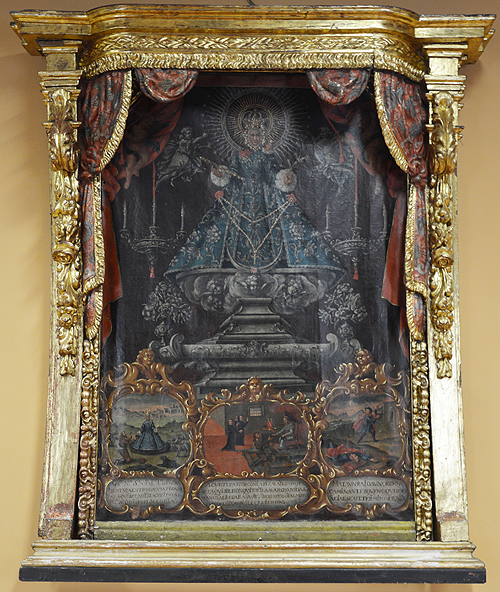
Canvas of the Virgin of Soterraña from the parish church of San Juan Bautista in Pamplona (Episcopal Palace).
In the context of the dissemination of the legend of the image and its appearance, many devotional prints and medals, pendants and decorative slate plaques were produced, whose invoicewould be made in a workshop or workshops of a certain specializationand in which the size of the plaque in question would be the circumstance that would determine the level of detail highlighted in each case. In fact, a large number of the miracles worked through his intercession involve people saved by wearing his medals or holy cards. Among the latter, those with vignettes stand out. We know of a couple of them in Navarre, very popular in Spain in the first half of the 18th century, one made between 1724-1725 and the other between 1715 and 1731. In both engravings, one of the vignettes depicts a crippled man being held by a woman inside a church and before the altar of the Virgin of Nieva, whose image appears under a canopy. The accompanying registration, in both cases, reads: "Vuelbe sanº a Navarro vecino de ella que vino arrastrando a visitar la Sª Imagen". This fact, which in its day was widely publicised, undoubtedly helped to spread devotion to the image in these lands, especially for healing the crippled and protecting against lightning and sparks.
Engravings of the Virgin of Soterraña were in demand everywhere, but the printing of these was reserved for the Segovian sanctuary. The right was granted by Philip V in 1733, at a time when the popularity of the Soterraña was on the rise. According to its content, the convent of Santa María de Nieva had the exclusive right to print and sell engravings, justifying this by stating that all those objects had to be touched to the right hand of the image of the Virgin "where the power of her precious Son had formed the figure or subjectof a lightning bolt, they were safe from any danger". Those prints that were not touched to the original did not possess that power against lightning and flashes of lightning, which is why they were thought to be a real fraud for devotees. In general, the points of sale of the prints were the Dominican convents, the same ones that complained about illegitimate prints in Segovia and other parts of the peninsula. We know of the various notifications made to silversmiths and printers so that in no case would they reproduce the images of the Soterraña, as they did not enjoy their powers as they had not been touched on the right hand side of the image. noticeDue to the fraudulent production of many silversmiths and printers, the convent of Nieva sent out circulars to engravers and goldsmiths, including hawkers, in Segovia, San Sebastián, Alcalá de Henares, Granada, Córdoba, Ávila and Arévalo, to inform them of the exclusive nature of this production. In 1768 there was still a warning to the city of Cordoba, where copies were still being printed.
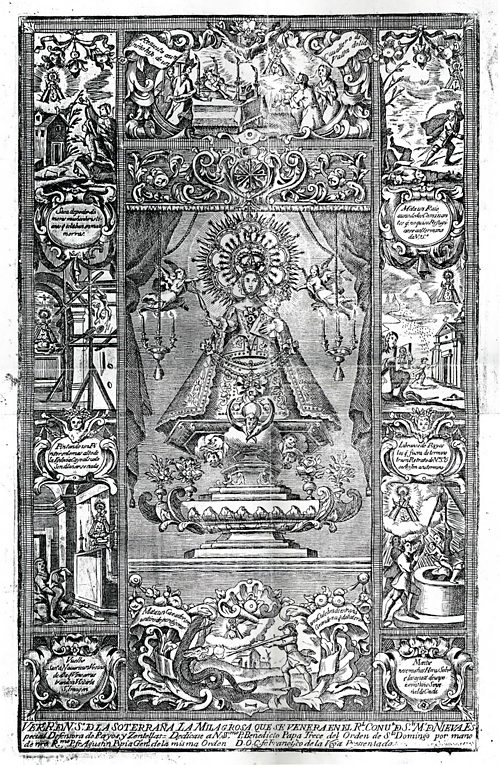
Engraving of the Virgin of Nieva. 18th century
The Pamplona parish church of San Juan Bautista, located in the cathedral, received an interesting canvas of the Virgin of Soterraña in 1733, donated by an anonymous devotee, adorned with a rich gilded frameworkand its beautiful canopy. The painting was in the attic of the altarpiece of San Pedro in the aforementioned parish church until the mid-20th century, when it was moved to the old dormitory of the cathedral, from where it was moved to the corridors of the Episcopal Palace some ten years ago.
Quite a lot of dataof the piece was collected in a parish transcriptthat we have located among the funds of his fileof the disappeared parish church. It contains, among other papers, the certification of the Dominican prior of the convent of Nieva, in which he certifies the authenticity of the painting, the notarial authentication and the receiptof José Pérez de Eulate for the making of the frameworkand canopy.
We reproduce the text of the prior's certification for its obvious interest, given the scarce issueof this subjectof documents. Its text reads: "I, the master of Sacred Theology, Fray Mauro Rodríguez, current Prior of the Royal Convent of Nuestra Señora de la Soterraña, Order of Preachers, of the town of Santa María la Real de Nieva, in the bishopric of the city of Segovia, a very special defender of lightning and sparks, certify that I have touched by my own person the original of the said miraculous image, a copy of it in a painting of a rod and slightly longer than five and a half centimetres and a half centimetres, a copy of her in painting of a rod and averagesomewhat longer and five quarters of a yard wide with her blue dress and a spike in her left hand and a sceptre in her right, with her two lanterns at the sides and three miracles at her foot, two of her glorious apparition and the other of the freedom and havoc of a thunderbolt, with their labels, which I am told goes out of devotion to the city of Pamplona. And for the record, I give the present signed in my hand in the said Royal Convent on the nineteenth day of April, one thousand seven hundred and thirty-three years. Fray Mauro Rodríguez, Presentado y Prior". The notarial authentication only adds the detail that the act of touching the original was done in the Virgin's boudoir in his presence and that of other persons, whose names he does not specify.
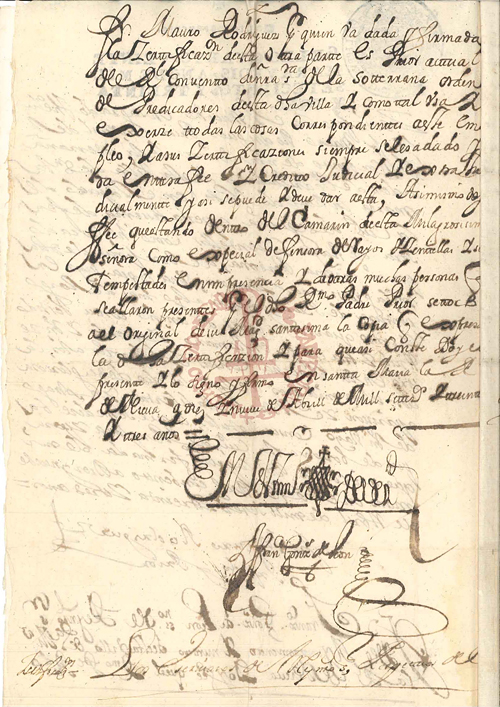
certificateon the painting, touched by the original image
The canvas arrived in Pamplona a few days later and the vicar of San Juan Bautista, Don Félix Amatriain, commissioned the prestigious José Pérez de Eulate to make the frameworkand canopy for it, known as the "adornment", the cost of which amounted to 24 ducats for the gilding and 200 reales for the carving work. On 24th May, the master signed the receiptcorresponding to his work.
The choir members of the parish asked the cathedral chapter to authorise a peal of bells to welcome him, but the canons refused on 22 May, stating that the placement of the painting was not sufficient cause, as well as complaining about the excesses of the parish in the cathedral precincts, especially the hindering of certain celebrations such as the Saturday mass.
With regard to the dates, we should remember the fires in Pamplona to which we have alluded, especially the one in March 1733 and the arrival in the city of the first image of the original, painted in bulk, at the request of a private individual on 31 May 1733 and its transfer to the Dominicans on 14 July of the same year. It seems that both images - the sculpture and the painting we are dealing with here - competed for their arrival, in a unique degree program, at the goalin the capital of Navarre, shortly after the explosion of the gunpowder mill and at a time when silversmiths from Estella and Pamplona had made medals of the same image, but without touching the original, as was done with measures, engravings and medals, which led to a severe warning of punishment from the author of the novena published in the Pamplona presses in that same year of 1733.
The impulse of devotion was undoubtedly the primary purpose of the painting. As Pérez Sánchez recalls, all those canvas images of virgins were intended, as "trompe l'oeil to the divine", for simple people, who inspired the same respect and devotion as the altarpieces, sculptures and sculptures of the altarpieces, sculptures and sculptures of the Virgin Mary. They inspired the same respect and piety in simple people as the altarpieces, sculptures and paintings in the churches, while at the same time, for a modest price - in the case of the prints - they could have their favourite devotions to satisfy their own particular devotions. In this way, the interest of many people in possessing the "true portraits" and "miraculous images", as venerated in the churches, was fully compensated by acquiring, by various means, the images of their fervour.
The painting is based on some of the numerous engravings that were made of the image, most of which included vignettes with the entire legend of her apparition and the main miracles, some of which are preserved in different places in Navarre. It does not follow the most usual practice of depicting the scenes on the sides, nor does it follow issue, which is usually larger in prints. Only three are incorporated in the lower part of the composition, as a base. From left to right are the apparition to the shepherd, his audience with the bishop and one of the most popular miracles, which narrates the death by lightning of a traveller who did not wish to gather at the edge of the sanctuary. The three passages with their corresponding cartouches are richly bordered with leaves and facing C's, very much in keeping with the tastes of the time. The first sampledepicts the Virgin in a landscape during her apparition. Its registrationreads: "APASE NA SA AL PASTOR Pº DE BVENA / BENTVRA ENTREGALE VNA PIZARRA / PARA QVE SE LA DE LA DE Y SEA CREIDO AL / ILMO SR OBISPO DE SEGOBIA". The second, in a more landscape format, continues the story, with the shepherd before the episcopal throne at the moment of submitthe slate and with a couple of the prelate's relatives, with evident gestures of admiration and surprise in the background. In the corresponding registrationwe read: "ACVDE EL PASTOR CON LA PIZARRA Y LOS PAJES / SE LA QUISIERON QVITAR Y LA ALLARON VNIDA A LA / MANO Y AL LLEGAR SV ILLMA SE DESPEGO SE Y ALMIRA / DOS DEL MILAGRO LE CREIERON". The third passage moves away, as we have indicated, from the legendary tale to insist on the protection of the Marian invocation in its protection against lightning and thunderbolts. Its composition copies the vignettes of the above-mentioned engravings. Its registrationreads: "MATA UN RAIO A VNO DE DOS / CAMINANTES QVE NO QVISO RE / FVGIARSE A EL TERMINO DE Nª Sª".

Our Lady of Soterraña. Vignettes at the bottom.
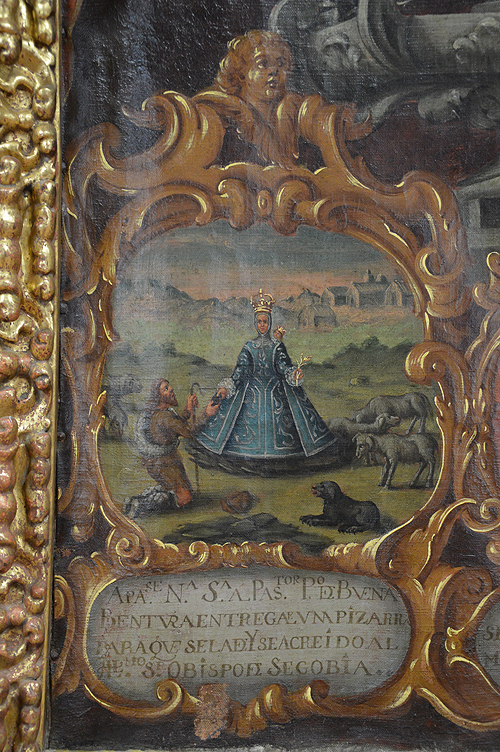
Our Lady of Soterraña. Apparition to the shepherd
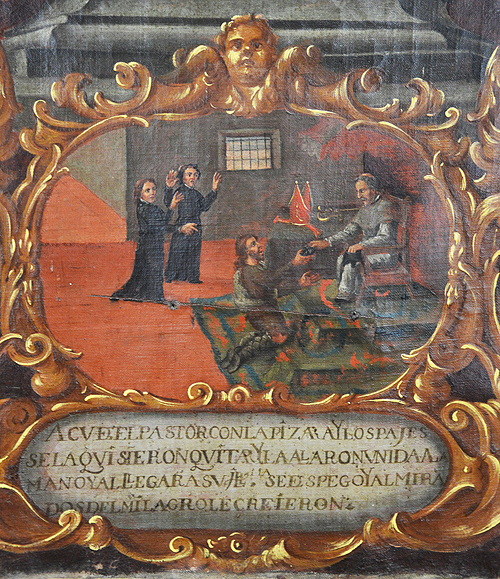
Our Lady of Soterraña. Pastor's audience with the bishop

Our Lady of Soterraña. Death of a walker by lightning
The image of the Virgin rests on the silver-plated pedestal and adopts the familiar frontal arrangement with a conical bodice and apron with a pendant rosary instead of the typical three-stranded pearl braid. She holds the sceptre in her right hand and, unlike the most widespread models, she does not hold the Child with her left hand, in which she exceptionally carries a spike, but holds him with her forearm. Another gradewhich does not usually appear in votive offerings, paintings and engravings is the coat of arms of the Dominican order which appears on the silver pedestal, instead of the canopy which usually accompanies the image, crowning the draperies which uncover the icon. The elaborate crown with the two angels is perfectly in keeping with the various printed examples known to us. The detail of the ear of corn must have been imposed on the painter by the promoters of the painting and speaks of the Virgin's protection of the crops. Perhaps it also alludes to a text from the prayers to the Virgin of Soterraña which reads: "The Virgin is an ear of corn that has never been threshed".
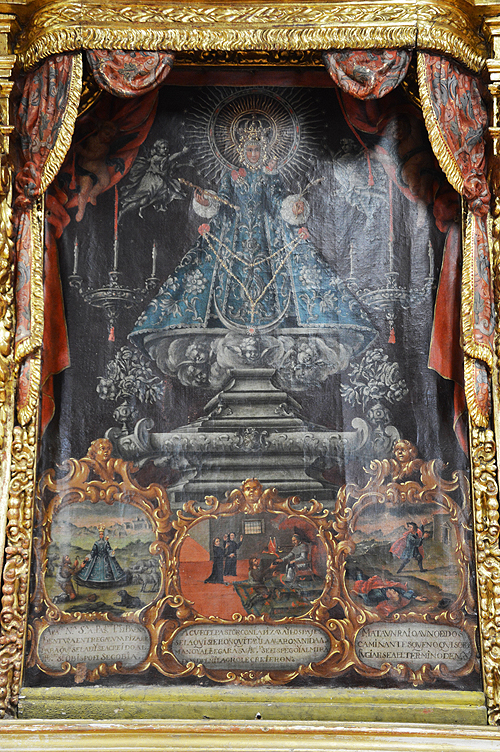
Our Lady of Soterraña (Episcopal Palace of Pamplona)
As for the authorship, it is very difficult to say whether the painting was made in Pamplona in order to take it to Santa María de Nieva and fulfil the ritual of touching it to the original, or whether it was made in Segovian workshops that were very accustomed to copying the image in different materials and techniques. It is a discreet work of invoice, with more of an iconographic and anthropological appearance and interest than an artistic one. The framing of the cartouches, very much of the period, is noteworthy.
The frameworkand canopy are documented examples of this subjectof gilded wooden pieces that were generally made in the workshops of the altarpiece makers and whose models were sometimes perpetuated for decades. Their author, José Pérez de Eulate (1703-1783) was one of the most important figures on the Pamplona art scene in the 18th century. He apprenticed with the sculptor Fermín de Larrainzar, marrying one of his daughters in 1726. His professional activity was boundless, and for more than forty years he held the post of overseer of works for the diocese of Pamplona. His altarpieces include those of the Poor Clares of Arizcun and the chapel of the Episcopal palace and the traces of those of the Benedictine nuns of Corella.
With regard to the donor, it is worth remembering the vicar Don Félix Amatriain, who is documented as the one who commissioned the frameworkand canopy and who years earlier donated to the parish of San Juan Bautista a large Crucifix with its canopy for the sacristy recently built between 1721-1722. The following year, the same vicar, together with the choirboys of the parish, paid for the new organ, which was to be finished the following year and for which he paid for the iron parapet. He also commissioned the reliquary of San Sebastián, the chest of drawers for the sacristy and gave several textile pieces as gifts.
SOURCES AND BIBLIOGRAPHY
fileDiocese of Pamplona. Parish Archives. San Juan Bautista de Pamplona. Certification of the image of Nuestra Señora de Soterraña and its arrival in Pamplona.
filePamplona Cathedral. Book III of conference proceedingsCapitulares, 1725-1755, fol. 119.
APRAIZ, A., "La Virgen de Nieva y su relación con Navarra", programs of study Segovianos, no. 1 (1949), pp. 358-366.
BARCÁIZTEGUI, A. de, Historia de la aparición milagrosa de la Imagen de N. Señora de la SOTERRAÑA de Nieva y Novena para implorar su auxilio, Pamplona, Francisco Picart, 1733.
ALARCÓN ROMÁN, C., "El poder de la imagen de Nieva reflejado en su leyenda y sus señales", Religión y cultura (coord. S. RODRÍGUEZ BECERRA), Sevilla, boardde Andalucía, 1999, pp. 103- 114.
ALARCÓN ROMÁN, C., "La iconografía religiosa en el siglo XVIII", Revista de Dialectología y Tradiciones Populares, t. XLV (1990), pp. 247-277.
CABEZAS, J., Historia prodigiosa de la admirable aparición y milagros portentosos de la imagen soberana de María Sansíssima Nuestra Señora de la Soterraña de Nieva, especialisima defensora de truenos, rayos, centellas y terremotos, Mexico, Imprenta del Nuevo Rezado de Doña María de Ribera, 1748.
FERNÁNDEZ GRACIA, R., El retablo barroco en Navarra, Pamplona, Government of Navarre, 2003.
PÉREZ SÁNCHEZ, A. E., "Trampantojos a lo divino", Lecturas de Historia del Arte. Ephialte (1992), pp. 139-155.
SILANES SUSAETA, G., Cofradías y religiosidad popular en el Reino de Navarra durante el Antiguo Régimen, Pamplona, Gráficas Pamplona, 2006.
TARIFA CASTILLA, M. J., "La parroquia de San Juan Bautista de Pamplona y su ajuar litúrgico", Cuadernos de la Chairde Patrimonio y Arte Navarro. I. programs of studyon Pamplona Cathedral in memoriam Jesús Mª Omeñaca, Pamplona, Chairde Patrimonio y Arte Navarro, 2006, pp. 375-387.
VILLAFAÑE, J., Compendio historico en que se da noticia de las milagrosas y devotas imágenes de la Reyna de cielos y tierra, María Santissima que se veneran en los mas celebres santuarios de Hespaña, Salamanca, Imprenta de Eugenio Garcia de Honorato, 1726, pp. 339-348.
YURAMI, A. M., Historia de la aparición de la taumaturga Ymagen de Nuestra Señora la Soterraña de Nieva, transcription and notes by A. SÁNCHEZ SIERRA, Madrid, A. Sánchez Sierra, 1995.
